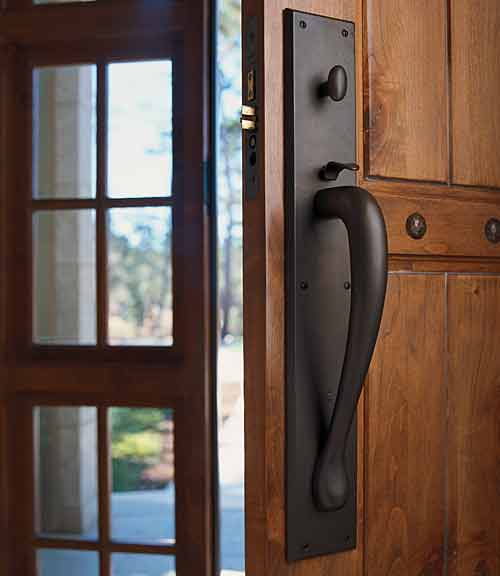Door Hardware Comes of Age
Selecting & Specifying Hardware
Hardware choices and selections are governed by the function of the door, the style and type of hardware that most suitably meets the door's operating requirements, and both the appearance and the tacit signals the designer wishes to convey, such as push, pull and turn.
Hardware selection begins with lock functions. Important conditions and considerations include the following:
Entry. This refers to an exterior door with keyed access, which can be provided in single cylinder or double cylinder functions.
- Mortise Lock−Recommended for use with heavy or high-use doors Specific trim selections require this type of lock. It is an integrated lock (see Glossary). Technical attributes of a mortise lock include saw proof inserts in the deadbolts, push button locking capacity, and emergency egress function (single operation exit). Highly recommended for use with grip handle and thumb latch application.
- Deadbolts−Usually combined with a lever or knob function or a push/pull plate.
Patio. This is an exterior door that does not require key access, but requires lock function, and is typically used on doors that access a balcony or patio. The same lock choices as entries apply, mortise lock or deadbolt. In most cases, exterior doors have keyed access from the outside in, to overcome potential redundancy-of-locking situations. This occurs when several doors are in close proximity to each other or when external access is directed towards a single door.
Privacy. This function has three locking options, all with varying levels of security and use.
- Mortise lock−The most secure locking feature for high-use areas.
- Mortise bolt−Although this locking mechanism is not substantially stronger than the push-button locking spring latch, it offers a more identifiable locking feature. For example, this may be used for a bathroom door so that it is more obvious that the door is locked, as opposed to a push button mechanism.
- Spring latch (locking)−This is the most affordable locking mechanism. It is not necessarily weaker than the mortise bolt, but it is less obvious that the mechanism is actually locked.
Passage. This is a non-locking mechanism with operable handles. It is used on doors that do not need to be secured.
- Spring latch−This is a latch operated by a handle.
- Mortise lock box−While there is no locking capacity, it has the same mortise box as a locking mechanism, and functions as a latch.
Dummy. This refers to a set of inoperable handles on one or both sides of a door. This could also be the inoperable side of a double door condition. Dummies are often used with a roller catch or another latching mechanism.
Multi-point. Originally developed in Europe, this mechanism latches the doorframe in three or more places. Many American window companies have adopted this system.
Miscellaneous Functions:
- Corridor−This function allows the inside handles on both sides of the door to be open and functioning. One side has a locking turn piece or push button, such as a mortise lock or locking spring latch. This is typically used to lock an office or room that is not in a public area.
- Classroom−This function allows the inside handle to always be free while the outside handle can either be free or be lockable with a key via a mortise lock or a locking knob or lever. This restricts the locking function to the key holder.
- Store room−The inside handle is always open or free and the exterior handle is always locked. The locking mechanism is keyed from the exterior side.
- Hotel entry−Similar to the storeroom, except that there is an emergency egress deadbolt on the interior, allowing guests the ability to secure their room from the inside.
|
Doors.The size, construction, and proportion of doors are important factors when selecting hardware.
- Stile width−Choosing the width of the escutcheon, the back plate that attaches to the door, depends on the available surface, or stile width, while factoring in the overlap of the stop. These dimensions are critical. The goal is to fit the hardware on the door with an accommodation for ease of operation, thus allowing room to grab the lever or grip without hitting the knuckles. Matt Ostmann, Technical Director at Rocky Mountain Hardware observes, "A common problem that arises often is that the selected stile is too narrow to carry the standard escutcheon. Choosing a narrow stile may severely limit the designer's hardware options."
- Door Size−Typically, the height of the escutcheon is directly proportional to the door height. This is a subjective choice.
- Handing−This is the convention that indicates where the door is hinged and in what direction it swings. The diagram in the Glossary reflects the hardware industry standard. It is important to use the convention as illustrated when handing is specified.
- Backset−This defines the length from the edge of the door to the center of the lock. Standard lengths for tubular or spring latches are 2-3/8 inches and 2-3/4 inches. Standard lengths for mortise locks are 2-1/2 inches and 2-3/4 inches. These can have options for custom backsets but stile and hardware choices may limit the available options.










